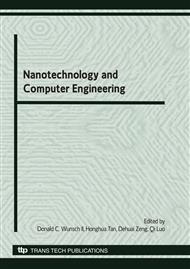[1]
Shunfeng Cheng; Kwok Tom; Thomas, L.; A wireless sensor system for prognostics and health management, IEEE Sensors Journal [J], 2010, 10(4): 856-862.
DOI: 10.1109/jsen.2009.2035817
Google Scholar
[2]
Kyong-Tak Cho; Saewoong Bahk. Duty cycle optimization for a multi hop transmission method in wireless sensor networks, IEEE Communications Letters[J], 2010, 3. 3(14): 269-271.
DOI: 10.1109/lcomm.2010.03.091809
Google Scholar
[3]
Li Hong, Li Guang-Hui, Feng Hai-Lin, Fault-tolerant routing in wireless sensor networks with redundant cluster-heads [J], Harbin Gongye Daxue Xuebao/Journal of Harbin Institute of Technology, 2009, 41(1): 80-85.
Google Scholar
[4]
Zhu, Mengxia; Ding, Song; Wu, Qishi; Brooks, R. R; Fusion of threshold rules for target detection in wireless sensor networks, ACM Transactions on Sensor Networks[J], 2010, 2. 6(2): 154-167.
DOI: 10.1145/1689239.1689248
Google Scholar
[5]
Zhang, Guang-Sheng; Guo, Yuan-Bo2; Xu, Zhen-Yang; Dou, Wen-Hua, A hop-adaptive routing algorithm for wireless sensor and actor networks, Tien Tzu Hsueh Pao/Acta Electronica Sinica[J], 2010, 1. 1(38): 13-17.
Google Scholar
[6]
Jerry Z., Ramesh G. Understanding packet delivery performance in dense wireless sensor networks[A]. In: Proceedings of SenSys'03[C]. ACM Press, Los Angeles, California, USA, 2003, 1-13.
Google Scholar
[7]
Hu Y. C., Johnson D. B. Design And Demonstration Of Live Audio And Video Over Multi-hop Wireless Ad Hoc Networks [A]. In: Proceedings of MILCOM'02[C]. IEEE Press, 2002, Vol. 2, 1211- 1216.
DOI: 10.1109/milcom.2002.1179651
Google Scholar
[8]
Douglas S. J., De C., Daniel A., John B., Robert M. A High-Throughput Path Metric for Multi-Hop Wireless Routing [A]. In: Proceedings of MOBICOM'03[C], ACM Press, San Diego, CA, USA. 2003, 134-146.
Google Scholar
[9]
Yu Kun-shi; Liu You-yuan; Cao Xiao-hua; Qi Chang-pu, The platform design of wireless sensor network with CC2420[J], Microcomputer Information, 2008, 35, 107-119.
Google Scholar
[10]
Bhatti, S.; Carlson, J.; Dai, H.; etc; MANTIS OS: an embedded multithreaded operating system for wireless micro sensor platforms[J], Mobile Networks and Applications, 2005, 4(10), 563-579.
DOI: 10.1007/s11036-005-1567-8
Google Scholar
[11]
M. Zuniga , B. Krishnamachari. Analyzing the transitional region in low power wireless links.
Google Scholar
[12]
Khan, S. A; Mulvaney, R. L; Hoeft, R.G. Direct-diffusion methods for inorganic-nitrogen analysis of soil. Soil Science Society of America Journal[J], 2000, 5. 3(64): 1083-1089.
DOI: 10.2136/sssaj2000.6431083x
Google Scholar


